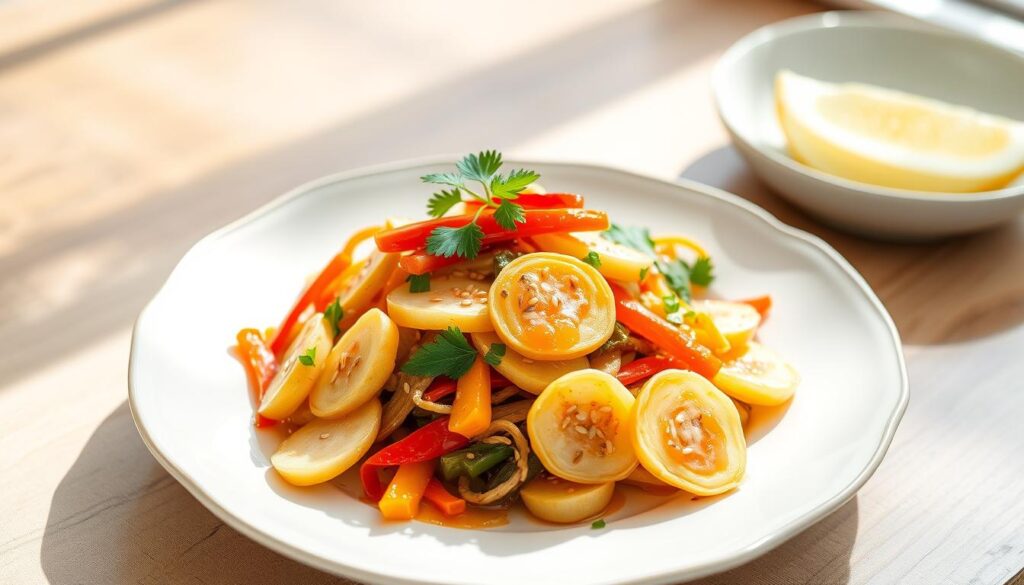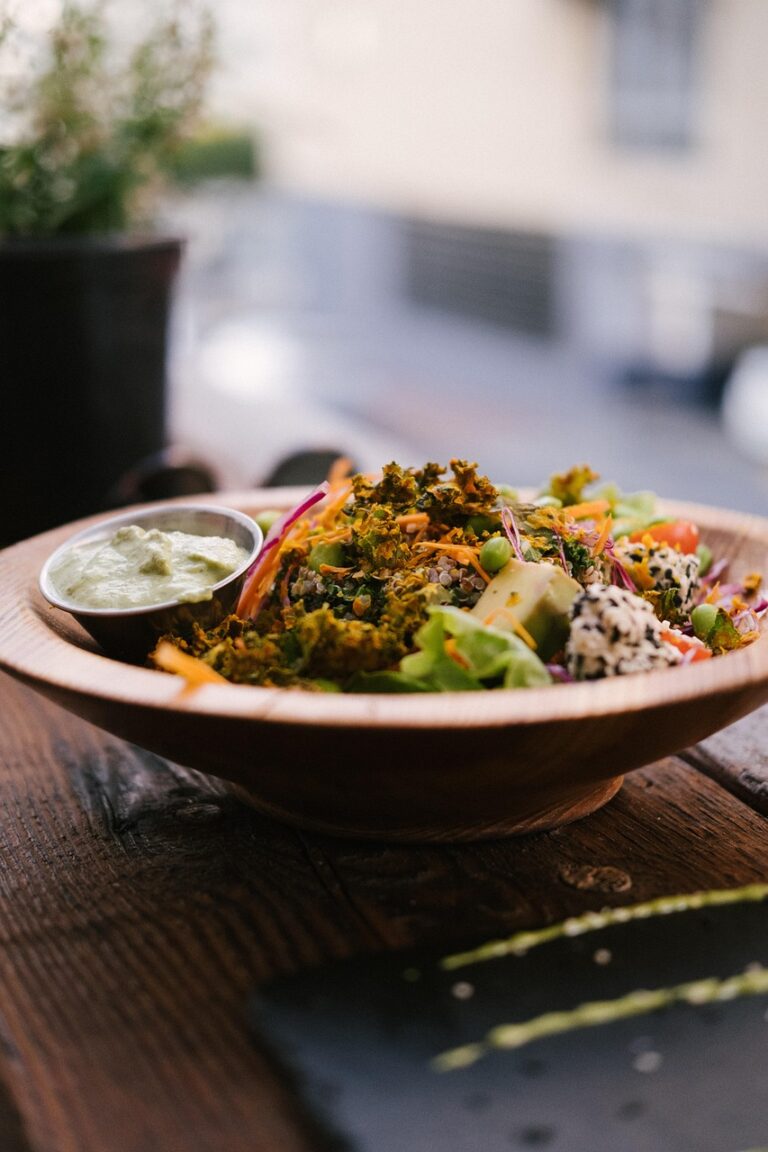Lotus Root Recipe : Vitamin C-Rich
Lotus root is a versatile ingredient used in many dishes. It can be found in traditional Asian recipes and modern fusion cuisine. To cook lotus root well, you need to know the basics of this ancient vegetable. The best recipes mix old techniques with new ideas, creating unique and tasty dishes.

Cooking lotus root is fun and rewarding, especially with fresh, quality ingredients. Whether you want a classic recipe or something new, knowing how to cook lotus root is key. It’s rich in history, nutrition, and culinary uses, making it a great meal addition. This guide will cover how to pick and prepare fresh lotus root, essential ingredients for traditional recipes, and healthy cooking methods.
Key Takeaways
- Lotus root is a versatile ingredient used in various dishes, including traditional Asian recipes and modern fusion cuisine.
- Understanding the basics of how to cook lotus root is essential for creating delicious dishes.
- The best lotus root recipes often combine traditional techniques with modern twists.
- Using fresh and high-quality ingredients is crucial for cooking lotus root.
- This article will provide a comprehensive guide to cooking lotus root, including Asian lotus root recipe and healthy lotus root recipe.
- Cooking lotus root can be a fun and rewarding experience with the right techniques and ingredients.
- This recipe has a rich history, nutritional benefits, and culinary uses, making it an excellent addition to any meal.
Understanding Lotus Root: An Introduction to This Ancient Vegetable
Lotus root has been a staple in Asian cuisine for centuries. It’s prized for its crunchy texture and sweet flavor. This makes it a key ingredient in many recipes.
Its unique characteristics and historical significance have led to the development of traditional recipes. These highlight its nutritional value and culinary versatility.
Physical Characteristics of Lotus Root
Lotus root is known for its distinctive appearance. It has a series of holes running through its length. This gives it a unique texture and visual appeal.
Historical Significance in Asian Cuisine
In many Asian cultures, lotus root is considered a symbol of good fortune and prosperity. It’s often used in traditional dishes, such as those found in traditional lotus root recipes.
Nutritional Profile Overview
Lotus root nutrition is rich in fiber, vitamins, and minerals. This makes it a nutritious addition to a variety of meals. It’s great for simple snacks or complex recipe preparations.
By understanding the physical characteristics, historical significance, and nutritional profile of lotus root, cooks can unlock its full potential. They can create delicious and nutritious meals using traditional and innovative recipes.
Selecting and Preparing Fresh Lotus Root
Choosing the right fresh lotus root is key for lotus root preparation. You can find it in many Asian markets. Look for roots that are firm and smell sweet and earthy.
To prepare fresh lotus root, start by rinsing it under cold water. Then, gently scrub the root with a vegetable brush to remove dirt or debris.
To learn how to cook lotus root, it’s important to know how to prepare it. You can slice, dice, or julienne fresh lotus root. Sliced lotus root is great in stir-fries or as a side dish. Diced lotus root is perfect for soups or stews.
Here are some tips for preparing fresh lotus root:
- Choose roots that are heavy for their size and have a sweet, earthy aroma.
- Rinse the root under cold water, then gently scrub it with a vegetable brush.
- Pat them dry with a paper towel to remove excess moisture.
- Store fresh lotus root in a cool, dry place to keep it fresh for up to a week.
By following these tips and learning how to cook lotus root, you can enjoy its unique flavor and texture. You can use it in traditional Asian dishes or modern fusion recipes.
| Preparation Method | Description |
|---|---|
| Slicing | Use a sharp knife to slice the lotus root into thin rounds or strips. |
| Dicing | Cut the lotus root into small cubes or dice for use in soups or stews. |
| Julienning | Use a mandoline or sharp knife to cut the lotus root into thin strips or julienne. |
Essential Ingredients for Traditional Lotus Root Recipe
Traditional lotus root recipes need basic seasonings and spices to highlight the lotus root’s unique taste. It’s crucial to have the right ingredients for a traditional lotus root recipe. Common ones include soy sauce, garlic, and ginger.
These ingredients help make various dishes, like stir-fries and soups. Besides these basics, other ingredients can also boost the flavor of traditional lotus root recipes. Some optional ones are:
- Sesame oil
- Green onions
- Mushrooms
- Bamboo shoots
By mixing these ingredients with the right lotus root ingredients, you can make a tasty and authentic Asian lotus root recipe. Whether you’re trying a new recipe or want to spice up your meals, these ingredients are a great starting point.
With the right ingredients and a bit of practice, you can make delicious and authentic traditional lotus root recipes. So, why not give it a try and see what you can create with these essential ingredients?
| Ingredient | Quantity | Usage |
|---|---|---|
| Soy sauce | 2 tablespoons | Marinade or stir-fry |
| Garlic | 3 cloves | Minced and sautéed |
| Ginger | 1 inch | Grated and sautéed |
Traditional Asian Lotus Root Recipe Methods
Traditional Asian lotus root recipes often use stir-frying, braising, or steaming. These methods highlight the natural sweetness and crunch of the lotus root. It’s a key ingredient in many Asian dishes.
Some common recipes include stir-frying sliced lotus root with garlic and ginger. You can also braise it in a rich sauce or steam it with herbs and spices. These methods are not only tasty but also simple to follow. Start by slicing the lotus root thinly, then heat oil in a wok or pan. Add your favorite ingredients and seasonings.
Here are some tips for cooking lotus root using traditional Asian methods:
- Stir-fry sliced lotus root with garlic and ginger for a quick and easy side dish
- Braise lotus root in a rich sauce made with soy sauce, sugar, and spices for a hearty and flavorful main course
- Steam lotus root with herbs and spices for a light and healthy snack

By following these traditional recipes, you can make delicious and authentic Asian dishes. Lotus root adds a unique flavor and texture to your meals. Whether you’re experienced or new to cooking, these recipes can add excitement to your dishes.
| Recipe | Ingredients | Cooking Method |
|---|---|---|
| Stir-fried Lotus Root | Lotus root, garlic, ginger, soy sauce | Stir-frying |
| Braised Lotus Root | Lotus root, soy sauce, sugar, spices | Braising |
| Steamed Lotus Root | Lotus root, herbs, spices | Steaming |

Healthy Lotus Root Preparation Techniques
Lotus root is a nutritious ingredient with many healthy cooking methods. You can make a healthy lotus root recipe by choosing the right cooking methods. Steaming and baking are great options because they keep the flavor and texture of lotus root intact.
Steaming Methods
Steaming is a favorite way to cook lotus root because it keeps its nutrients. Just put the lotus root in a steamer basket and steam for 10-15 minutes. It will be tender when done.

Baking Options
Baking is another healthy way to cook lotus root. Preheat your oven to 400°F (200°C). Then, bake the lotus root for 20-25 minutes until it’s tender.
Air Fryer Variations
Air frying is a modern method that uses little oil and keeps nutrients. Slice the lotus root into thin rounds. Air fry at 375°F (190°C) for 10-15 minutes until crispy.

These healthy preparation techniques let you make a tasty and nutritious dish with lotus root. You can choose from steaming, baking, or air frying. There’s a healthy lotus root recipe for everyone to enjoy.
Authentic Indian Lotus Root Recipe Variations
Indian cuisine is full of lotus root recipes, each with its own taste and texture. The indian lotus root recipe is a favorite in many homes. Its many versions show India’s rich food history.
In India, authentic indian cuisine is famous for its strong flavors and spices. Lotus root recipes are no different. Each region in India has its own special way of making lotus root recipes.
Regional Variations
Some popular indian lotus root recipe variations include:
- North Indian style preparations, which often feature rich and creamy sauces
- South Indian adaptations, which tend to be lighter and more flavorful, with a focus on coconut and spices
These variations show the diverse food traditions across India. They give a peek into the country’s rich cultural heritage. Whether you want to try a traditional indian lotus root recipe or try something new, there’s plenty to discover.

Tips for Achieving the Perfect Texture
To get the perfect lotus root texture, pay close attention to cooking time, temperature, and technique. Learning how to cook lotus root well is key. It brings out the best in this ancient vegetable.
Here are some valuable lotus root tips for the perfect texture:
- Cook the lotus root at the right temperature to prevent it from becoming too soft or too hard.
- Adjust the cooking time according to the thickness and size of the lotus root slices.
- Use the right technique, such as steaming or stir-frying, to preserve the natural texture of the lotus root.
By following these lotus root tips and understanding how to cook lotus root, you can enjoy a delicious dish. The secret to the perfect lotus root texture is cooking with care and attention to detail.
Common Mistakes to Avoid When Cooking Lotus Root
Cooking lotus root requires care to avoid mistakes. One big error is not controlling the temperature right. This can make the root overcooked or undercooked.
Another mistake is preparation errors. Not peeling it right or not removing the bitter core are common. To avoid these common cooking mistakes, follow some lotus root cooking tips. Here are a few tips to remember:
- Choose the right cooking method, like steaming or boiling, to keep the root’s texture and flavor.
- Keep an eye on the temperature and cooking time to prevent overcooking or undercooking.
- Make sure to prepare the root correctly, including peeling and removing the bitter core.
By following these lotus root cooking tips and avoiding common mistakes, you can make a tasty and healthy dish. Always handle the root with care and attention to detail for the best results.
Storage and Preservation Methods
Keeping lotus root fresh is key to its longevity. Store it in a dry place to avoid spoilage. You can keep fresh lotus root in the fridge for up to a week. Wrap it in a damp cloth or plastic bag to keep it moist.
For longer storage, try freezing or pickling. Freezing is great for keeping the root’s texture and taste. Just slice or chop it, blanch in boiling water, and then freeze in airtight containers or bags.
Fresh Storage Guidelines
- Store fresh lotus root in the refrigerator at a temperature below 40°F (4°C).
- Keep the root away from direct sunlight and moisture.
- Use a breathable container or bag to maintain air circulation.
Freezing Instructions
- Slice or chop the lotus root into desired sizes.
- Blanch the lotus root in boiling water for 2-3 minutes to inactivate enzymes.
- Shock the blanched lotus root in an ice bath to stop the cooking process.
- Store the frozen lotus root in airtight containers or freezer bags.
Follow these tips for storing and preserving lotus root. This way, you can enjoy its delicious taste all year round.
Health Benefits and Dietary Considerations
Lotus root is packed with nutrients, offering many lotus root health benefits. It’s high in fiber and vitamins. This makes it a great addition to a healthy diet, boosting overall health.
When thinking about dietary considerations, lotus root is a smart choice. It’s low in calories but high in fiber. This is good for those trying to lose weight or improve their digestion.
Some key lotus root health benefits include:
- High fiber content to support healthy digestion
- Rich in vitamins and minerals, such as vitamin C and potassium
- Low in calories, making it an excellent choice for weight management
Adding lotus root to your diet can bring many lotus root health benefits. It helps with digestion and provides important nutrients. Knowing the lotus root nutrition and dietary considerations helps make smart food choices.

Pairing Suggestions and Serving Ideas
Lotus root pairs well with many ingredients, making it a versatile vegetable. You can enjoy it with traditional flavors or modern twists. It’s perfect for creating unique and delicious dishes.

Traditional Accompaniments
Classic pairings for lotus root include soy sauce, ginger, and garlic. These flavors enhance its natural sweetness. Here are some favorite traditional pairings:
- Soy sauce and ginger
- Garlic and chili flakes
- Sesame oil and vinegar
Modern Fusion Combinations
For a modern twist, try pairing lotus root with lemon juice, herbs, and spices. These add a fresh and exciting flavor. Here are some modern pairings to try:
- Lemon juice and parsley
- Herbs and spices, such as cumin and coriander
- Balsamic glaze and roasted vegetables
When serving lotus root, think about combining it with other ingredients. It’s great in salads, stir-fries, and soups. Its unique texture and flavor make it a standout in many dishes.
Conclusion
The journey into the world of lotus root has been eye-opening. We’ve learned about its unique look and its role in traditional Asian dishes. It’s clear that this ancient veggie adds flavor and variety to any meal.
Whether you choose to steam, bake, or air fry your lotus root, you’re set for success. The methods discussed in this article will help you make tasty and nutritious dishes.
As you try out more lotus root recipes, don’t be afraid to explore different tastes and textures. From hearty North Indian dishes to light South Indian ones, the options are vast. With the right spices and sides, lotus root can be a real showstopper in your cooking.
Let this article be your starting point for exploring lotus root in the kitchen. Be ready to face challenges, learn from mistakes, and enjoy the thrill of mastering this fascinating veggie. With creativity and a spirit of adventure, the world of lotus root cooking awaits you.
FAQ
What is the nutritional profile of lotus root?
Lotus root is packed with nutrients. It’s full of fiber, vitamins, and minerals. It’s a great source of vitamin C, vitamin B6, potassium, and manganese. It also has antioxidants and other good plant compounds.
How can I select and prepare fresh lotus root?
Choose fresh lotus root that’s firm, smooth, and without blemishes. Avoid soft or discolored roots. Rinse, peel, and slice or dice it as needed for your recipe.
What are the essential ingredients for traditional lotus root recipes?
Traditional recipes use soy sauce, garlic, ginger, rice vinegar, and sesame oil. You might also add mushrooms, scallions, or chili peppers for extra flavor.
What are some healthy lotus root preparation techniques?
Steaming, baking, and air frying are healthy ways to cook lotus root. They help keep its nutrients while making it tasty.
Are there any authentic Indian lotus root recipe variations?
Yes, Indian cuisine has many lotus root recipes. North Indian recipes use cumin and coriander. South Indian recipes might include coconut, mustard seeds, and curry leaves.
How can I achieve the perfect texture when cooking lotus root?
To get the right texture, control cooking time and temperature. Avoid overcooking to keep it crunchy.
What are some common mistakes to avoid when cooking lotus root?
Don’t cook at too high a heat, and make sure to peel and slice properly. These steps are crucial for the best results.
How should I store and preserve fresh lotus root?
Store it in the fridge, wrapped in a damp paper towel or in an airtight container. For longer storage, freeze it after blanching in an airtight container or bag.
What are the health benefits of consuming lotus root?
Lotus root is full of fiber, vitamins, and minerals. It can help with digestion, blood sugar, and inflammation.
What are some good pairing suggestions and serving ideas for lotus root?
Lotus root goes well with many ingredients. Try it with soy sauce, rice vinegar, and scallions for a traditional taste. For something new, mix it with citrus, herbs, or spices.







